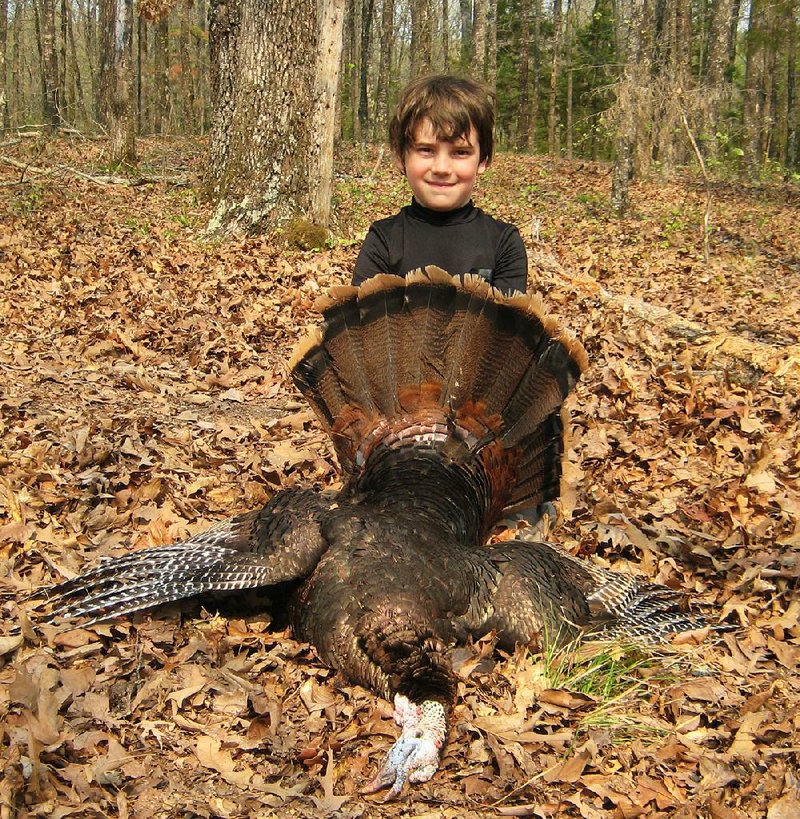Turkey season opens April 18, a day of great anticipation and excitement for veteran turkey hunters across the Natural State.
Novice and first-time turkey hunters want to catch the bug, too, but many are also anxious because they might not know where to go or what equipment they need.
Grant Westmoreland of Sheridan, a member of the National Wild Turkey Arkansas board of directors, said turkey hunting can be a simple and inexpensive sport to enter and be successful.
"You don't need a lot," Westmoreland said. " For beginners, box calls are best because they're real easy to operate. Push button calls are real easy to operate: Push a button, and it makes a turkey sound. It can't get any easier than that. They're foolproof."
A Primos push-button yelper was my first call, and I used it to call up one of my biggest gobblers on the morning of my first spring turkey hunt in Missouri in 2001. I also used it to call up two mature gobblers while scouting two days before that hunt.
Westmoreland, who said he started turkey hunting 15 years ago, said a rookie is just as likely to be successful as a veteran.
"My first turkey was a double-bearded gobbler that weighed 22 pounds," Westmoreland said. "Needless to say, I was hooked to kill a trophy turkey like that my very first time in the woods."
The most important factor is to hunt where turkeys live.
Westmoreland said a deer lease might have turkeys, but Arkansas also has a lot of public land. Some of it is wide open to hunting, and some of it hunters have to draw a permit, but they have to find a place to scout for turkeys.
When scouting, you're looking for clues that turkeys inhabit the area, such as tracks, droppings, feathers or bare places in the leaves that turkeys have scratched out looking for food.
One mistake Westmoreland has made more than once is hunting an area that looks good but he didn't take the time to scout. Just because it looks like it should have turkeys doesn't mean it will.
Turkey tracks are distinctive. They are large, three-toed prints. Fresh prints will have well-defined edges.
Turkeys often lose feathers while fighting, strutting or when flying in or out of roosts. A wild turkey's wing feather is wide and tapered with brown and white barring. An adult gobbler's wing feathers are barred all the way to the tip.
Many turkey hunters rub out footprints with their boots and carry feathers out of the woods.
"Turkey hunters aren't like deer hunters," Westmoreland said. "Deer hunters share information and help each other out. Turkey hunters will lie to you. It doesn't matter how good a friend they are, we tend to clam up around each other this time of year."
For beginning hunters, Westmoreland advised being subtle in your calling and to be patient.
"Beginners want to over-call, and they want to move a lot," Westmoreland said. "The guy that helped me a lot when I was learning was Justin Stewart. He's an accomplished turkey hunter. He said, 'If you think you need to move, don't. Always give it another 10 or 15 minutes.' "
Bill Rhodes of Sheridan makes custom turkey calls. He said novices shouldn't be overly influenced by contest calling or by the dramatic calling they hear on television. Westmoreland agreed.
"I've been around a lot of calling contests, but calling contests are for human ears," Westmoreland said. "Some of the worst calls I've ever heard were from hen turkeys. Our voices crack, and so do theirs."
Rhodes said novices often mimic contest callers by calling too loudly. Hen turkeys make subtle sounds that other turkeys can hear from long distances. If a gobbler is nearby when you make a blaring call, it will likely end the hunt.
"Most of the turkeys I've called in have been when I was working the caller real light and soft," Rhodes said.
Turkeys often run to a call, so make sure you are concealed and in position to shoot before you make a call, a mistake Westmoreland made on his first hunt.
"Before I sat down and got my mask on, I called," he said. "I was about to put my mask on when three jakes walked in on me, and I was stuck. If a turkey is real close, he might step on you before you have a chance to get ready."
A similar incident happened to me in 2009 while hunting on the East End Hunting Club in Grant County. I put a decoy on a trail and made a few yelps, but I had to answer a nature's call. Three jakes skidded to a halt in front of the decoy. It was an awkward moment for us all. They spun around and ran away as fast as they arrived.
Spring turkey season runs April 18-May 3. The season limit is two adult gobblers, and it is illegal to kill immature gobblers, or jakes. Consult the 2015 Arkansas Turkey Hunting Guidebook, published by the Arkansas Game and Fish Commission, for regulations and other useful information.
Sports on 04/05/2015
